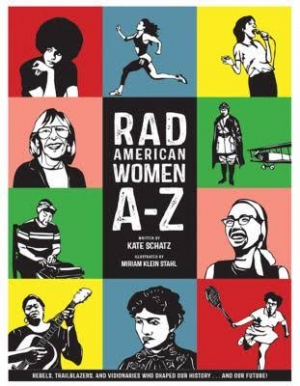
Radical Children's Literature
Julia Mickenberg discusses some recently published radical children's literature.
As Philip Nel and I suggested in “Radical Children’s Literature Now!", the contemporary field of radical children’s literature is so large that it is impossible to encompass. Still, several recently published, self-consciously radical books that directly or indirectly aim to motivate young children into activism point to the challenges and limitations of taking on this mode of writing for the young.
At least on the surface, all of these books appear to address young children. Most are abecedaries and all are picture books - one of them is actually a board book. I will argue, however, that none of them are actually good for very young children and only one of them is truly radical in the sense of adopting a developmentally-appropriate form for encouraging children to challenge social injustice.

ABC’s of Anarchy (2010) is very much a DIY enterprise: it’s self-published using open-source and free software. Under Creative Commons licensing the author, Brian Heagney tells readers they can copy, alter, and distribute the book as long as they credit him. The DIY ethos has it drawbacks: the book has spelling errors and production quality is low, but in an introduction the author both admits to the limitations of his project and says he doesn’t expect his book to provide the last word on anarchy for children: “Hopefully there will soon be many ABCS’s of Anarchy books on the market, so we can once and for all rid the world of the negative connotations of that beautiful word, Anarchy.”
Despite positive reviews on Amazon this does not seem like a book for children. At the most basic level, the language and concepts would be incomprehensible to a young or even an older child, with terms like “B is for Black Bloc (“a group of people dressed in black to represent either mass solidarity for a cause or mass resistance to oppression), or “H is for Hierarchy” showing Maslow’s Hierarchy of Needs. There are ideas that even the most countercultural parent would probably not want to suggest to their (young) child, as in “T is for Train-Hopping: . . . the art of sneaking onto trains and riding to your destination for free.” The illustrations are of low quality, with little attention to composition or proportion. On the positive side, after every statement there are questions that might inspire useful dialogue with children. For example, under “W is for World Without Borders” it asks, “What are some naturally occurring borders you encounter on a daily basis? What are some human-made borders you encounter on a daily basis?” And under G is for Gender Role, it asks “ Why do you think some toys and activities are considered either masculine or feminine?”

A is for Activist (2013) is much more professionally done and more visually appealing, but I still question its appropriateness for young children, despite being a board book. The book, by Indonesian-born graphic designer Innosanto Nagara, founder of a worker-owned design studio dedicated to “serving the movement,” was funded through a Kickstarter campaign and ultimately published with Sevenstories press. With phrases like “C is for Co-op/Cooperating Cultures. Creative Counter to Corporate vultures” and Q, “Querying Qualities counter false assertions,” I find it difficult to imagine the language of this book appealing to children (my children, 10 and 13, just laughed when we read “Z is for Zapatista/of course” (I try to keep them informed, but they had no idea who Zapatistas are). The book’s visuals are appealing but not always for reasons that serve the book’s intended message. On the cover, a black, green-eyed cat, mysteriously suspended upside down above and slightly to the right of the title becomes a motif, to which we’re alerted after several pages, under “C” (“Oh, and Cats. Can you find the Cats?”). Thus the child not especially interested in the book’s message can still be engaged by the search for cats. The rest of the illustrations are beautiful, so if nothing else a child might enjoy looking at the pictures. Beyond the cats, there are moments in which the author seems to suddenly remember his child readers, as in the lovely two-page spread of multi-cultural children eating pizza, popsicles and watermelon (“H is for Healthy food—a Human right).
“N is for NO. No! No! No! Yes to what we want. No to what must go! No! No! No!” is a sentiment many board-book reading children can identify with, but it’s unclear whether they’d associate the idea with collective solidarity or social justice.

A Rule is to Break: A Child’s Guide to Anarchy (2012) is more appealing to a child (“I wish the author was my mother!” my 10-year-old daughter proclaimed after I read it to her), but it’s not necessarily a book that serves children well. Originally self-published by the husband-and wife comic artists John Seven and Jana Christy, it’s appealing visually and most of the messages are great, eg.: “Don’t look like everybody else!” and “Educate yourself. Use your Brain,” and “Build it. Don’t buy it.” But there are others messages that, while appealing to children, are harder for parents (or this parent) to swallow, such as “When someone says ‘work!’ you say WHY?” “Stay up all night!” “NO baths ever again!” and “Do what you want!” As one reviewer on Amazon notes, “I do wish they had pointed out that breaking even nonsensical, arbitrary, and counterfeit rules has consequences.” Put in terms of child development, as psychologist Elisabeth Young-Bruehl notes in The Irreducible Needs of Children , children have an “irreducible need” for “’limit setting, structure, and expectations,’” and they certainly don’t get that here.

Rad Women A to Z written by Kate Schatz and illustrated by graphic artist Miriam Klein Stahl, succeeds where the other books fail. Although an abecedary, it’s really for older children and is actually common core aligned for grades 3-8. Instead of telling children what to do, most of the book describes inspiring women of different races and sexual preferences (there’s even a trans woman, Kate Borenstein) who made important scientific discoveries (Virginia Apgar); worked for environmental justice (Rachel Carson), workers’ rights (Dolores Huerta, Lucy Parsons), civil rights (Angela Davis, Ella Baker, the Grimke sisters, Wilma Mankiller, Yuri Kochiyama), or educational access (Jovita Idar), or broke down barriers in the arts (Isadora Duncan, Ursula LeGuin, May Lin, Patti Smith, Odetta), athletics (Billie Jean King, Florence Griffith-Joyner), and professions (Sonia Sotomayor). This is done through engaging and accessible text and iconic, powerful, bloc-print illustrations.
An introduction asks, rhetorically, “What does it mean to be ‘rad’?” and goes on to explain: “‘rad’ is short for radical, which comes from the Latin word meaning ‘from the root.’” In that sense, “rad” can describe people like Ella Baker, who did grassroots organizing, or people who worked to make bigger changes in society, like Angela Davis or the Grimke sisters. We’re told that radical can also mean “different from the usual.” And that “’rad’ is also a slang word that means ‘cool’ or ‘awesome.’” Although the bulk of the book is devoted to short biographies, each woman named with a descriptive epigraph at X, devoted to “the women whose names we don’t know” readers are invited to change the world themselves. Schatz declares that “X is for all we don’t know about the past, but X is also for the future,” and then asks “What will you do to make the world rad?” The book ends with another note to readers, noting how many more women might be included, suggesting that children do a book report or “draw a picture or make a sculpture of your favorite rad woman,” and offering a list of “26 things you can do to be rad!”, one for each letter of the alphabet, from “Act” to “Give,” to “Hope” to “Understand.”
If radical parents want their children to adopt their values and to embrace a life of activism, they may naturally turn to books to help them. But they should consider those books quite carefully: are the books written for a child’s benefit, or for an adult’s? Almost all children’s books are written by adults, and very often they are created with adult buyers rather than child audiences in mind. Truly radical children’s literature is attentive to a child’s needs and desires and to a child’s cognitive and emotional capacities. In appealing to a child’s sense of right and wrong radical children’s literature assumes children’s capacity to act but also recognizes the limits to children’s agency, and all children’s vulnerability. Children ought to gain a sense of social responsibility, and literature can be an excellent vehicle for this. But those wishing to cultivate that sense should choose their books wisely.

